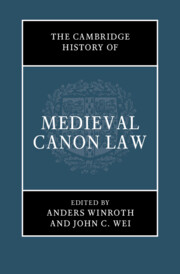Book contents
- The Cambridge History of Medieval Canon Law
- The Cambridge History of Medieval Canon Law
- Copyright page
- Contents
- Figures
- Maps
- Tables
- Contributors
- Acknowledgments
- Abbreviations
- Medieval Canon Law: Introduction
- Part I The History of Medieval Canon Law
- Part II The Sources and Dissemination of Medieval Canon Law
- Part III Doctrine and Society
- Iudicium
- Clerus
- Conubium
- Crimen
- 26 Criminal Law
- 27 Ecclesiastical Discipline: Heresy, Magic, and Superstition
- 28 Just War and Crusades
- 29 Excommunication and Interdict
- Conclusion
- Bibliography of Primary Sources
- Index
- References
26 - Criminal Law
from Crimen
Published online by Cambridge University Press: 13 January 2022
- The Cambridge History of Medieval Canon Law
- The Cambridge History of Medieval Canon Law
- Copyright page
- Contents
- Figures
- Maps
- Tables
- Contributors
- Acknowledgments
- Abbreviations
- Medieval Canon Law: Introduction
- Part I The History of Medieval Canon Law
- Part II The Sources and Dissemination of Medieval Canon Law
- Part III Doctrine and Society
- Iudicium
- Clerus
- Conubium
- Crimen
- 26 Criminal Law
- 27 Ecclesiastical Discipline: Heresy, Magic, and Superstition
- 28 Just War and Crusades
- 29 Excommunication and Interdict
- Conclusion
- Bibliography of Primary Sources
- Index
- References
Summary
A history of ecclesiastical criminal law has yet to be written. In this limited space, we will not attempt to accomplish such an ambitious task. Instead, the aim will be to provide a general overview of how medieval ecclesiastical law contributed to the development of public criminal law.
Keywords
- Type
- Chapter
- Information
- The Cambridge History of Medieval Canon Law , pp. 495 - 510Publisher: Cambridge University PressPrint publication year: 2022
References
Select Bibliography
- 1
- Cited by

